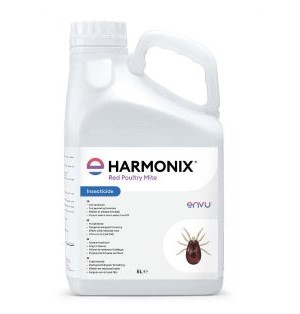Usually less than 2 mm long. There is little evidence of segmentation. The body consists of the sac-like idiosoma and the gnathosoma, which carries the mouthparts and sensory organs. The mouthparts include a pair of 3-segmented chelicerae, which may be pincer-like or piercing. The idiosoma is rounded or oval and the dorsal
surface sclerotized with shield-like plates. Adults have eight legs, which are usually well developed, the front pair being employed as sensory organs rather than for walking. There is a single pair of spiracles opening between the second and third or third and fourth pair of legs. Metamorphosis is incomplete with egg, larval and nymphal stages.
Species characteristics:
Poultry Red Mite (Chicken Mite) (Dermanyssus gallinae)- Adults, 0.7 –1.0 mm long
- Idiosoma oval, colourless to bright red or grey-black (if containing partially digested blood)
- Chelicerae of females well developed, narrow towards the tip and approximately half as long as the idiosoma
- Dorsal surface with weak sclerotisation and pairs of setae
Sometimes confused with the Red Poultry Mite although it lives on the host and is active during the day. Chelicerae do not narrow at the tip and bear shear-like chelae with no teeth or setae
Areas where found:
A cosmopolitan species widely distributed throughout Europe. It is found naturally in wild bird nests, the small size of the mites making them ideally suited to a close association with birds. They feed on blood and are particularly associated with the nests of pigeons, starlings, sparrows, swallows and house martins. When the
birds fledge and leave their nests the mites may disperse and infest nearby buildings including poultry units. Adult mites are resistant to dessication and starvation and can survive without food for several months. Extreme temperatures e.g. >45° C and -20° C are lethal and survival is best at higher relative humidities e.g. 70%.
Red poultry mites are important pests in poultry units and appear in all types of production systems. Conditions in poultry houses are ideal for the mites and large populations can rapidly develop. The mites are nocturnal and spend the day resting in cracks and crevices where they are safe from predation by the birds. At night time they quickly move onto the birds and will feed for up to two hours. Freshly fed mites are bright red in colour but, as the blood is digested, they gradually turn darker and eventually become colourless. Mites can be introduced into poultry units from infestations associated with wild birds, with newly introduced poultry, on equipment, transport or clothing.
When the mites infest buildings they will attack people causing painful and irritating bites. Large infestations in poultry houses may lead to a number of problems including:
Disturbance and stressing of the birds, which may be reluctant to use infested nests.
Increased feather pecking.
Anaemia, leading in severe cases to death.
Transmission of diseases.
Red poultry mites are implicated in the transmission of Salmonella spp., Erysipelothrix rhusiopathiae (the causative agent of erysipelas), Newcastle virus etc.
Reduced productivity:
- Reduced weight gain
- Reduced egg production
- Smaller eggs
- Inferior shell quality
- Inferior yolk colour
- Contamination with mites and their faeces
Lifecycle:
Female mites lay as many as 40 eggs in batches up to seven at a time, 12–24 hours after taking a blood meal. The eggs are oval, cream-coloured and approximately 0.4 mm long. They are laid in nests, cracks and crevices around roost sites and hatch in 1–3 days to give 6-legged larvae. The larvae do not feed and remain inactive until they moult within two days to give 8-legged nymphs. Like the adults, nymphs take blood meals, usually during the night, and spend the day sheltering in
cracks and crevices in and around the nests. There are typically two nymphal stages before they moult to become adults. Under favourable conditions the full life-cycle takes about a week.
Assessment of infestations
Populations of Red poultry mites can establish themselves very quickly and, as infestations become deep-seated, they are difficult to control. Regular monitoring is important to ensure infestations are dealt with at the earliest opportunity. Mites may be collected from birds or resting sites, but the fact that they are not active
during the day and hide in cracks and crevices means it may be difficult to measure populations. They can be expelled from harbourages e.g. equipment by tapping them onto sheets of paper.
a) Hygiene/management
Infestations associated with wild bird nests can be controlled by removing and destroying the nests with due regard to any statutory protection which exists for the bird species involved. In poultry houses, efforts should be made to limit the harbourages available for the mites. This can be achieved by limiting the use of wood, employing impervious materials which are easy to clean, equipment design and sealing potential refuges. Care should be taken not to introduce infestations via newly introduced poultry, on equipment, transport or clothing. Buildings should be proofed to prevent the ingress of wild birds, which may be infested. Thorough cleaning of the empty poultry house, including the outside, by power washing, steam cleaning etc. will control the mites and should precede the application of acaricides. Equipment should be dismantled as necessary and be thoroughly cleaned.
b) Acaricidal control
Where infestations are associated with wild bird nests, the infested areas should be treated with a suitable acaricide. Infested areas of poultry houses should be
treated as soon as they are identified, paying particular attention to mite harbourages. Thorough treatments with acaricides should also be made when houses have been cleared and cleaned.
___________________________________________________________________________________
Glossary of terms:
Chelicerae: Anterior appendages (mouthparts).
Gnathosoma: Segments bearing the mouth and its appendages.
Idiosoma: Sac-like body bearing legs.
Setae: Bristle or “hair” of invertebrates.

